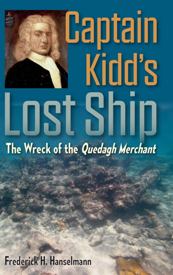 Pirates and Privateers Pirates and Privateers
The History of Maritime
Piracy
Cindy Vallar, Editor
& Reviewer
P.O. Box 425,
Keller, TX 76244-0425
    
Books for
Adults ~ Archaeology

Captain Kidd’s Lost Ship: The
Wreck of the Quedagh Merchant
by Frederick H. Hanselmann
University Press of Florida, 2019, ISBN
978-0-8130-5622-7, US $85.00
    
On 30
January 1698, William Kidd and the crew of Adventure
Galley seized a merchant ship known as Quedagh
Merchant. She was laden with “1200 bayles of
muslins, raw silk and calicoe of all sorts, fourteen
hundred bags of brown sugar, 84 bayles of raw silk
and eighty chests of opium . . . [along with] iron
and saltpeter and other goods of less value” (38)
They had sailed to the Indian Ocean to capture
pirates; instead, Kidd was denounced as a pirate. To
clear his name, he sailed Quedagh Merchant
to the Caribbean, where she later sank. He was
eventually arrested and taken to London, where he
stood trial for murder and piracy.
Captain Kidd’s Lost Ship recounts Kidd’s rise
and fall, the demise of both him and his prize, and
her rediscovery. Far from the simple telling of a
privateer who becomes a pirate, this volume delves
much deeper into the myth, history, and archaeology
surrounding one of the best-known episodes in pirate
history. The following quote from page one best
explains the purpose of this book.
Archaeology
is not solely the excavation of a site and the
recovery of its artifacts; it includes an
investigation of the social activity surrounding
a site and its formation, the historical
context, the actions of individuals in the past
as related to a site, and the management and
preservation of a site for public benefit and
future generations.
Hanselmann deftly
recounts not only the scientific and theoretical
sides of the story but also showcases how one
person’s actions and decisions, in combination with
those of others and the states involved, snowballed
into the loss of both ship and man. It is a tale of
interconnected networks – the English East India
Company, Armenian traders, sailors, privateers, and
piracy – in a global tapestry that reaches from the
Indian Ocean to the Caribbean and several points in
between. Hanselmann explains how they identify the
shipwreck and how the Dominican Republic decides to
turn this archaeological find into a Living Museum
in the Sea.
Even those familiar with William Kidd’s rise and
fall will find new information within this book and
come away with a better appreciation of who this man
is, what he does, and how global changes play a
significant part in his story. The step-by-step
review of all aspects allows readers to better see
“the differences between the commonly held view of
Kidd and his vessel that has been passed down
through the centuries and the true tale of Kidd’s
rise and fall in a much broader context.” (2) The
inclusion of contemporary documents, some of which
may not appear in other works on Kidd, are an added
bonus to a book that is well written. To further
place this episode within its historical context,
Hanselmann includes a Chronology of Events. There is
also a list of cited literature and an index.
While the theoretical explanations may mislead some
to think this is a pedantic treatment of a
fascinating subject, the author provides a gripping
account of how archaeologists sift through myths and
legends to discover the reality. Hanselmann provides
a well-rounded, more complete glimpse into Kidd and
the world in which he lives. It’s one of the best
demonstrations of how actions have consequences and
how those consequences impact individuals in real
world situations. As a result, Captain Kidd’s
Lost Ship is an invaluable and informative
addition to any maritime, archaeological, or
piratical library.
Review Copyright ©2020
Cindy Vallar

Click to contact me
Background image compliments
of Anke's Graphics |

